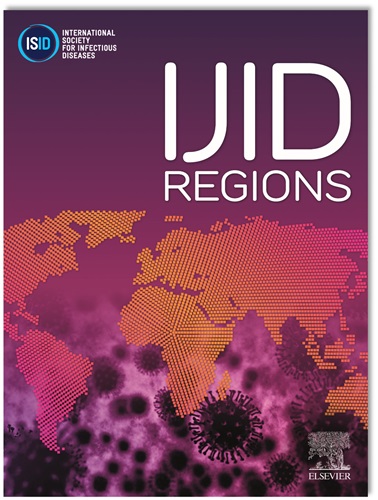Persistence of positive Brucella Melitensis blood cultures is not associated with focal infection
IF 4.8
2区 医学
Q1 INFECTIOUS DISEASES
引用次数: 0
Abstract
Objectives
Brucellosis is a global zoonotic disease complicated by focal infections requiring treatment modifications. In other bacterial infections, persistent positive blood cultures prompt evaluation for metastatic foci. We aimed to assess whether persistent bacteremia predicts focal infections in patients with Brucella melitensis infection.
Methods
We conducted a retrospective cohort study from 2010 to 2022. We included adults hospitalized due to Brucella melitensis bacteremia. Patients were categorized into persistently positive (PFUBC), negative (NFUBC), or no follow-up cultures. The primary outcome was focal infection (FI).
Results
Of 108 patients included, 74.8% exhibited persistent bacteremia (PFUBC). FI occurred in 27.8% of cases. Persistent bacteremia was not associated with FI occurrence. Localizing symptoms at presentation strongly predicted FI (OR: 9.4; 95% CI, 3.24-27.4). Among FI-negative patients, PFUBC status was associated with a significant increase in imaging studies (mean 1.8 vs 0.9; P = 0.003) and physician encounters (17.4 vs 11.9; P = 0.012), but did not improve clinical outcomes.
Conclusion
Persistently positive blood cultures in B. melitensis bacteremia do not predict focal infections or adverse clinical outcomes but significantly increase healthcare resource utilization without clinical benefit. Clinical symptoms should guide diagnostic evaluations rather than repeated blood cultures.
持续呈阳性的梅利氏布鲁氏菌血培养与局灶性感染无关。
背景:布鲁氏菌病是一种全球性的人畜共患疾病,伴有局灶性感染,需要调整治疗。在其他细菌感染中,持续的血培养阳性提示转移灶的评估。我们的目的是评估持续性菌血症是否可以预测布鲁氏菌感染患者的局灶性感染。方法:2010 - 2022年进行回顾性队列研究。我们纳入了因布鲁氏菌菌血症住院的成年人。患者被分为持续阳性(PFUBC)、阴性(NFUBC)或无随访培养。主要结局为局灶性感染(FI)。结果:纳入的108例患者中,74.8%出现持续性菌血症(PFUBC)。FI发生率为27.8%。持续性菌血症与FI的发生无关。表现时的局部症状能强烈预测FI (OR 9.4;95% ci 3.24-27.4)。在fi阴性患者中,PFUBC状态与影像学检查的显著增加相关(平均1.8 vs 0.9;P =0.003)和医生接触(17.4 vs. 11.9;P =0.012),但没有改善临床结果。结论:melitensis菌血症持续阳性血培养不能预测局灶性感染或不良临床结果,但会显著增加医疗资源的利用,而无临床效益。临床症状应指导诊断评估,而不是重复血培养。
本文章由计算机程序翻译,如有差异,请以英文原文为准。
求助全文
约1分钟内获得全文
求助全文
来源期刊
CiteScore
18.90
自引率
2.40%
发文量
1020
审稿时长
30 days
期刊介绍:
International Journal of Infectious Diseases (IJID)
Publisher: International Society for Infectious Diseases
Publication Frequency: Monthly
Type: Peer-reviewed, Open Access
Scope:
Publishes original clinical and laboratory-based research.
Reports clinical trials, reviews, and some case reports.
Focuses on epidemiology, clinical diagnosis, treatment, and control of infectious diseases.
Emphasizes diseases common in under-resourced countries.

 求助内容:
求助内容: 应助结果提醒方式:
应助结果提醒方式:


